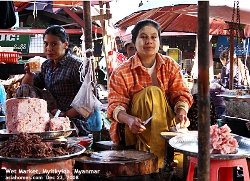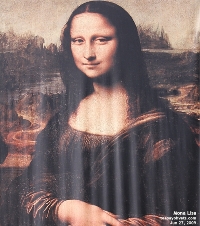"Go out and see the painting," the salesgirl said after I had spent a few minutes viewing several paintings displayed on the wall behind her small desk. Mrs Aung's eyes widened as she thought that this young salesgirl was being rude to me.
As I had been asking her questions about a big painting of the Yangon's Golden Pagoda (Shwedagon Pagoda) hanging behind her counter, I thought she wanted me to view this painting from outside her small art gallery.
I could not view this painting closely as she was sitting down talking to a customer and her desk was between the painting on the wall behind her and me in front of her. The painter was Di Pa. The front door was just behind my back since this was a very small art gallery. The only one in Peninsula Plaza which has various business specialising in Burmese matters in Singapore.
Mrs Aung thought she was being rude to a senior citizen. She was brought up to show respect for the elders. However, there was no reason for the salesgirl to be rude. She was trying to communicate to me something in English.
What was the miscommunication? Why did she ask me to go out of her office? The Shwedagon Pagoda painting behind her was not that big. In fact, I could have walked behind her desk to appreciate the fine painting.
This personable salesgirl, a Myanmar National was probably telling to communicate with me something. But what was she trying to tell me? I don't blame her for not communicating well in English. English is a difficult language to master and unless she had the opportunity to speak English more, she could not be fluent in this language.
As her gallery was so small, I thought that she might want me to view more paintings displayed outside her office, behind the glass wall of the front of her office and to the right of her desk.
I exited her gallery in the wink of an eye. It was a 150 sq. ft gallery and so it took 1 second to go out. I was correct in my interpretation of her good intentions. Two very big paintings of the Pao Market by KWK, occupying nearly 1/3 of the front glass window captured my attention due to its size, colours and composition of people in a wet market. "Where is Pao Market in Myanmar?" I asked the salesgirl as I read the name of the painting. "It is (pronounced as) Pa-O Market. It is in the Shan State," the salesgirl enlightened me when I said "Pao" market.
 "This is the type of painting I
appreciate," I told Mrs Aung
that each person has his or her
own interest in paintings and I
like paintings of the ethnic
groups going about their daily
lives in Myanmar (see photo,
left).
"But it is very big wet
market painting and
would take up 80% of the wall in
my reception room at Toa Payoh
Vets. It would not be appropriate
for a small wall."
"This is the type of painting I
appreciate," I told Mrs Aung
that each person has his or her
own interest in paintings and I
like paintings of the ethnic
groups going about their daily
lives in Myanmar (see photo,
left).
"But it is very big wet
market painting and
would take up 80% of the wall in
my reception room at Toa Payoh
Vets. It would not be appropriate
for a small wall."Mrs Aung had no interest in paintings. Once she said to me that I must be too free or too rich to look at paintings. Many people are struggling to earn a livelihood in this time of severe economic recession.
Mrs Aung said: "All paintings are original as the artist must create them. It is only the quality of paint and the canvas that affects the painting that must be considered."
I had taken Mrs Aung to see a small painting of a market scene in the Shan State in another office in Peninsula Plaza before we came to this small art gallery. In that office, I fell in love with a Market Scene painting very much. It connected to me instantly. It was also the right size to put in my small reception room of 50 sq ft at Toa Payoh Vets. It showed a young and pretty lady buying flowers from a poor flower girl in the wet market in Myanmar. Most likely, it could be a Pyin Oo Lwin market. Almost like a realistic painting from a photograph.
"It is not the original painting," I lamented to Mrs Aung. "It is a photocopied painting." Now, I don't appreciate colour copies for display.
Mrs Aung strongly disagreed. "All paintings are original. The artist has to paint them. So how could there be copies?"
It was difficult to educate Mrs Aung as she was brought up in a world of finance. Her father was a banker and she knew more about business than arts.
 "Well," I had a brain-wave. "All
paintings of Mona Lisa are copies,
except for the original one in a
French Museum".
"Well," I had a brain-wave. "All
paintings of Mona Lisa are copies,
except for the original one in a
French Museum".Mrs Aung stared at me. Mona Lisa, painted by Da Vinci, can be the most famous painting in the world but to Mrs Aung, I was talking Greek to her. She had never heard of Mona Lisa in her 40 plus years of living.
The salesgirl smiled at my mention of Mona Lisa. This girl certainly knew her business of Art. She looked at me with her big brown eyes and assured me: "All paintings here are certified."
The salesgirl showed me a small brochure with information of the paintings by Di Pa and KWK on display at her gallery. I did not know what she meant by "certification" but I presumed she meant the paintings were not copies. They were originals painted by the artists themselves. No fakes or reproductions.
It will be some time before Mrs Aung would be able to tell the differences between original, copies and reproduced versions of art. If she had a small interest in art education, she could learn fast. Then she could pick up great paintings at low prices in Myanmar. Being a businesswoman, she would have one additional product to sell to Singapore people who are "too free or too rich" and make money. To her, art would be a commodity for trading rather than a source of appreciation. However, to be able to sell successfully, she would need to be motivated to know more about the business of art. The business of Art is a difficult business as the seller needs to know much about the works of the artists and the paintings to be able to sell effectively.
 TOA
PAYOH VETS
TOA
PAYOH VETS